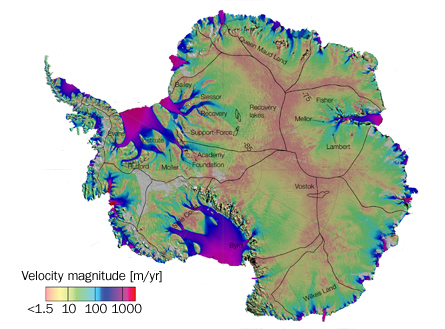Earth & Environment
Antarctic ice flows, atmospheric response to nuclear fallout and more in this week's news
Icy flows
A new map of Antarctica assembled from satellite radar data reveals how ice shifted around on the frozen continent between 2007 and 2009. Ice flowing through narrow channels forms a river-like tributary system that accounts for much of the movement, a team led by Eric Rignot of the University of California, Irvine reports online August 18 in Science. Researchers want to better understand how great ice sheets like Antarctica’s respond as global temperatures rise. —Alexandra Witze

Arctic may get breather in sea-ice losses
Roughly half of the recent loss of summertime Arctic sea ice appears to be due to greenhouse gas emissions as a result of human activity, the rest from natural climate variability, report scientists at the National Center for Atmospheric Research in Boulder, Colo. Their new analyses also indicate that even as global warming continues, summer Arctic sea ice losses could pause. “We could see a 10-year period of stable ice or even an increase,” says lead author Jennifer Kay. Her team’s analyses appeared online August 11 in Geophysical Research Letters. —Janet Raloff
Japanese fallout left electric signature
Radioactive fallout from the tsunami-crippled Fukushima reactors in Japan caused a rapid and dramatic response in the atmosphere’s electric field. The effect, brought about by a change in the atmosphere’s charge, showed up 150 kilometers southwest of the nuclear facility. Similar changes have occurred elsewhere after nuclear weapons tests and the Chernobyl accident, usually as rain washed fallout from the air. The Japanese radiation signature instead marked the arrival of fallout carried by dry low-altitude winds, scientists from Japan and Sweden reported online August 12 in Geophysical Research Letters. They conclude that early-warning electrical sensors be installed around all reactors to detect fallout. —Janet Raloff






